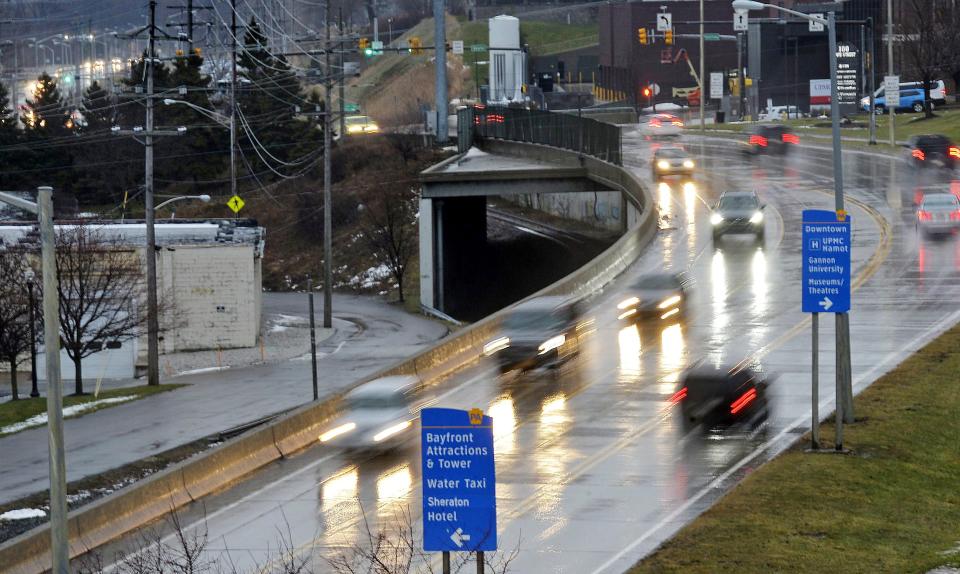New Erie Bayfront Parkway design serves traffic, not people, leaders must pause it now
PennDOT's Bayfront Parkway project website emits an aura of divine providence. Brimming with catchwords like "outreach," "connectivity," "collaboration" and "growth," the reader gets the impression that the state has orchestrated a triumph of democracy, wrought from the will of the people. It works. City government along with Erie's most influential stakeholders have endorsed the project, and effervescent reporting in the local media has been bubbling up.
In contrast, citizens and advocacy groups vested in Erie's future have been taking a cautious view. They've set aside such celebrations to instead consider the bayfront's sad legacy of social barriers — not just due to its industrial heritage, but also to those caused by the parkway itself over the past two decades. They believe PennDOT's reconstructed parkway will worsen those barriers rather than remove them. Of particular concern are the project's potential negative impacts on Erie's east bayfront neighborhood between Holland Street and the Soldiers' and Sailors' Home.
More: PennDOT's $154M Erie construction season ends. Here's what got done, plus 2023 preview
More: Bayfront Parkway federal lawsuit tossed by judge, clearing way for construction project
Their apprehension is appropriate. While the project's media team frames its purpose as an enhancement of connectivity between the city and the bayfront, a close look at the numbers buried in PennDOT's website, in my opinion, reveals its real objective: doubling through-traffic along the parkway. The project aims to deliver a carefree, crosstown jaunt for even more low-occupancy cars and industrial vehicles, driven by folks with little engagement with the central neighborhoods through which they're passing. I think that to suggest, as the project's website does, that increased traffic is complementary to improved pedestrian/cyclist access to the bayfront is absurd. PennDOT's unabashed merging of these contradictory aims has gone unchallenged.
It's worth exploring how what I view as preposterous notions like this work their way into the urban planning milieu. Departments of transportation share an archaic legacy dating back to President Eisenhower's signing the 1956 Federal Aid Highway Act, legislation that funded the construction of America's interstate highway system. With federal dollars flowing, cities across the country set about destructing the livability of their cores, slashing through neighborhoods and waterfronts with massive highways designed solely to pump nonlocal traffic directly through them. More often than not, these neighborhoods were — and still are — home to society's most vulnerable people. As those urban interstates failed to accommodate ever-increasing through-traffic, DOTs repeatedly returned to their mantra of wider and faster, encouraging even more traffic. Until only recently, no one considered whether placing such impactful societal matters into the hands of a transportation department was responsible — much less socially just or environmentally sustainable.
Somehow though, in this era where many cities are tearing down these big highways and restoring the livability of central neighborhoods, PennDOT has convinced Erie's leaders and influencers that more, faster traffic is a good thing for our community's growth and safety. Until now, the city and those stakeholders have not challenged the correctness of putting PennDOT in the driver's seat of such critical affairs.
It's imperative they do so now, and pause this project.
A lot of low-income folks and people of color live in the east bayfront neighborhood, more so than anywhere else in Erie County. If the project goes forward as planned, this already-vulnerable population will be subject to greater levels of noise and air pollution. In this context, it must be understood that massive roundabouts like the one planned directly in front of the Blasco Library are noisy, desolate, inhumane places that only encourage faster speeds for the vehicles approaching and departing them. Despite the inclusion of a pedestrian bridge — one with steep ramps that will bar its use by many people — local residents will be even further landlocked away from bayfront amenities. The roundabout is a force fit in every possible dimension — geometrically, topographically and culturally.
If safety for pedestrians, cyclists and drivers is indeed the objective here, less impactful alternatives to that roundabout as well as the one planned at Sassafras Street are available. Erie already has other routes with adequate through-traffic capacity. There is no need to encourage more nonlocal traffic on the Bayfront Parkway. If reducing congestion and accidents at major intersections along it is desired, speed controls can easily be introduced along the parkway to accomplish that without inconveniencing local traffic. And reducing the posted speed limits on it — seldom enforced by either the state or city police — will restore the artery's character as a parkway, rather than the expressway that it is evermore becoming.
In my view, PennDOT and its engineering consultants are inherently ill-equipped to take the lead on critical societal matters that have much more to do with the prosperity and security of Erie's central residents than the outmoded business of channeling even more traffic through the city's core. It is far better to place the conceptualization of this project in the hands of institutions qualified to holistically evaluate and plan for the societal needs of the local population and businesses — and to only use PennDOT as an engineering/construction resource further downstream during the implementation process.

The city's leaders and its most influential stakeholders still have an opportunity to pause this project, and hand over this affair to people competent in managing what is not merely an infrastructure project — but rather a critical social matter that will impact Erie and the region for generations to come.
Mark Osiecki is an Erie native, working internationally as a project manager on infrastructure and pollution control projects.
This article originally appeared on Erie Times-News: Erie Bayfront Parkway project serves traffic not people, hit pause now

